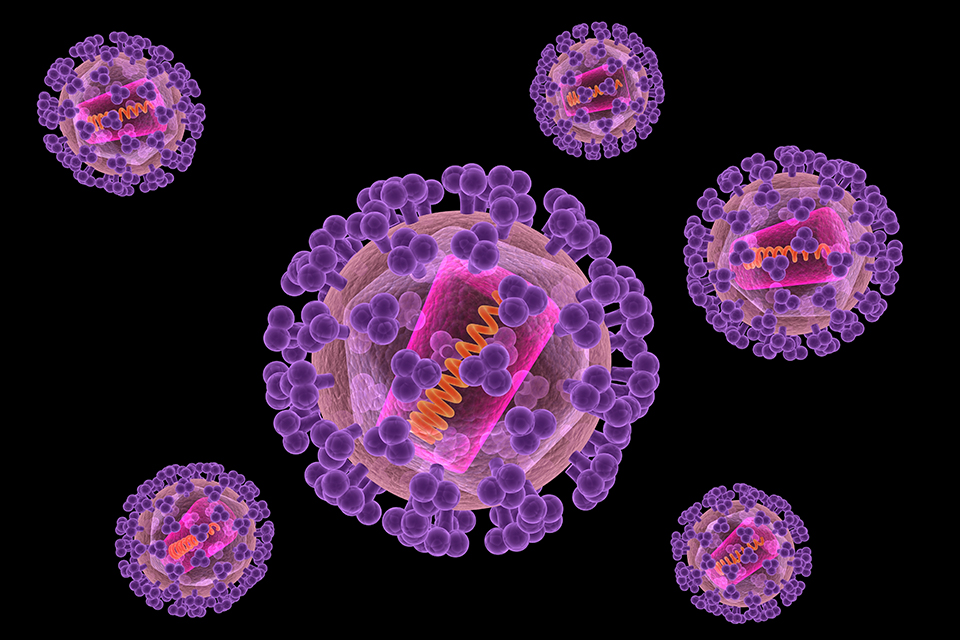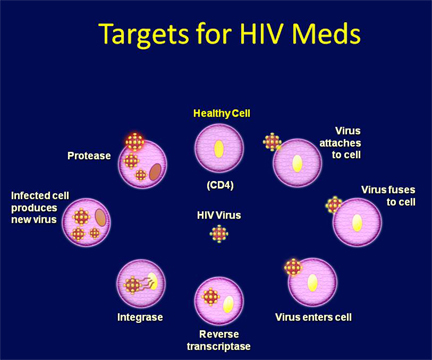
Lea esta hoja informativa en español
Table of Contents
The Basics
HIV drugs cannot cure HIV, but they can help you stay healthy by preventing the virus from reproducing (making copies of itself). If HIV is not able to reproduce, it will not infect new cells in your body and your viral load remains low. With a low viral load, you are more likely to have a healthy immune system and are less likely to transmit HIV to others. When your viral load is undetectable (too low for a standard test to measure), you cannot transmit HIV to a partner during sex. This is the foundation for HIV treatment as prevention.
HIV must go through a number of different steps in order to make copies of itself. This is called the HIV lifecycle. All HIV drugs work by interrupting a step in HIV's lifecycle; this stops HIV "in its tracks."
Click above to view or download this fact sheet as a PDF slide presentation
The HIV Lifecycle
Once HIV is in the body, it targets and infects a certain type of white blood cell called a CD4 cell. HIV then takes over or "hijacks" these cells and turns them into factories that produce thousands of copies of the virus. Each time HIV uses the cell to make more of itself, it destroys the CD4 cell. That is why the CD4 cell count of a person living with HIV gets lower when their HIV is not treated.
The steps HIV goes through to complete this process are:
- Binding and Fusion: HIV begins to enter a CD4 cell by binding, or attaching itself, to a specific point, called a CD4 receptor, on the cell's surface. HIV must then bind to a second receptor, either the CCR5 co-receptor or the CXCR4 co-receptor. This allows the virus to join, or merge, with the CD4 cell in a process called fusion. After fusion, HIV releases its genetic material and enzymes (proteins that cause chemical reactions) into the CD4 cell.
- Reverse Transcription: HIV's genetic material is called RNA. It contains the "instructions" that will reprogram the CD4 cell so that it produces more viruses. To be effective, HIV's RNA must be changed into DNA. An HIV enzyme called reverse transcriptase changes the HIV RNA into HIV DNA.
- Integration: Next, the newly formed HIV DNA enters the nucleus (command center) of the CD4 cell. Another HIV enzyme called integrase combines, or integrates, HIV's DNA with the CD4 cell's DNA.
- Transcription: Once the virus has become part of (is integrated into) the CD4 cell, it commands the CD4 cell to start making new HIV proteins. These proteins are the building blocks for new HIV viruses. They are produced in long chains.
- Assembly: An HIV enzyme called protease cuts the long chains of HIV proteins into smaller pieces. As the smaller protein pieces come together with copies of HIV's RNA, a new virus is put together (assembled).
-
Budding: The newly assembled virus pushes ("buds") out of the original CD4 cell. This new virus can now target and infect other CD4 cells.
Approved HIV Drugs
Please note: New HIV drugs and combinations of drugs are still being approved. This fact sheet is scheduled to be updated each year. If you want to ensure you are seeing the most recent list of approved drugs, check the list at HIVinfo, an HIV resource from the US National Institutes of Health.
The US Food and Drug Administration (FDA) has approved several classes of HIV drugs:
- Entry Inhibitors: These drugs stop (inhibit) HIV from entering a CD4 cell. There are different types of entry inhibitors — fusion inhibitors, receptor blockers (CCR5 antagonists), attachment, and post-attachment inhibitors. One of each type is approved:
- Fusion inhibitor: Fuzeon (enfuvirtide or T-20)
- CCR5 antagonist: Selzentry (maraviroc)
- Attachment inhibitor: Rukobia (fostemsavir)
- Post-attachment inhibitor: Trogarzo (ibalizumab)
- Integrase Inhibitors: These drugs interfere with HIV's integrase enzyme. There are several integrase inhibitors available for HIV treatment:
- bictegravir (in a combination pill; see below)
- elvitegravir (in several combination pills; see below)
- Isentress (raltegravir)
- Tivicay (dolutegravir)
- Vocabria (cabotegravir or CAB)
- Nucleoside and Nucleotide Reverse Transcriptase Inhibitors (NRTIs or "nukes"): These drugs interfere with HIV's reverse transcriptase enzyme. There are many approved NRTIs:
- Emtriva (emtricitabine or FTC)
- Epivir (lamivudine or 3TC)
- Retrovir (zidovudine or AZT)
- Tenofovir alafenamide fumarate or TAF (in several combination pills, see below; also sold separately as Vemlidy for the treatment of hepatitis B)
- Videx (didanosine or ddI) (no longer used in the US)
- Viread (tenofovir disoproxil fumarate or TDF)
- Zerit (stavudine or d4T) (no longer used in the US)
- Ziagen (abacavir)
- Non-Nucleoside Reverse Transcriptase Inhibitors (NNRTIs or "non-nukes"): Like NRTIs, these drugs interfere with HIV's reverse transcriptase enzyme. There are a number of approved NNRTIs:
- Edurant (rilpivirine or RPV)
- Intelence (etravirine or ETR)
- Pifeltro (doravirine or DOR)
- Rescriptor (delavirdine) (no longer used in the US)
- Sustiva (efavirenz) (only in combination pill)
- Viramune (nevirapine)
- Protease Inhibitors (PIs): These drugs interfere with HIV's protease enzyme. There are many approved PIs:
- Aptivus (tipranivir)
- Crixivan (indinavir) (no longer used in the US)
- Invirase (saquinavir) (no longer used in the US)
- Lexiva (fosamprenavir)
- Norvir (ritonavir) (generally used as a boosting agent; see below)
- Prezista (darunavir)
- Reyataz (atazanavir)
- Viracept (nelfinavir)
- Capsid Inhibitor: This drug interferes with the shell that protects HIV's genetic material. It can work at different stages of the HIV lifecycle. One capsid inhibitor has been approved:
- Sunlenca (lenacapavir)
- Boosting Agents: These drugs do not affect HIV's lifecycle; rather, they improve, or 'boost', the level of other drugs in the bloodstream so that the other HIV drugs can be taken at a lower dose.
- Norvir (ritonavir)
- Tybost (cobicistat)

- Fixed-Dose Combinations: Although not a separate class, there are fixed-dose drugs that combine two or more HIV drugs from one or more classes in just one dose, usually in pill form. This can make taking the medication easier. Many combination pills have been approved, including:
- Atripla (Sustiva plus Emtriva plus Viread)
- Biktarvy (bictegravir plus Emtriva plus tenofovir alafenamide)
- Cabenuva (Vocabria plus Edurant; available as a monthly injection)
- Cimduo (Epivir plus Viread)
- Combivir (Retrovir plus Epivir)
- Complera (Emtriva plus Viread plus Edurant)
- Delstrigo (Pifeltro plus Epivir plus Viread)
- Descovy (Emtriva plus tenofovir alafenamide (TAF))
- Dovato (Tivicay plus Epivir)
- Epzicom (Epivir plus Ziagen)
- Evotaz (Reyataz plus Tybost)
- Genvoya (elvitegravir plus Tybost plus Emtriva plus tenofovir alafenamide fumarate (TAF))
- Juluca (Tivicay plus Edurant)
- Kaletra (lopinavir plus Norvir)
- Odefsey (Emtriva plus tenofovir alafenamide (TAF) plus Edurant)
- Prezcobix (Prezista plus Tybost)
- Stribild (Emtriva plus Viread plus elvitegravir plus Tybost)
- Symfi and Symfi Lo (which contains a lower dose of Sustiva) (Sustiva plus Epivir plus Viread)
- Symtuza (Prezista plus Tybost plus Emtriva plus tenofovir alafenamide (TAF))
- Triumeq (Ziagen plus Tivicay plus Epivir)
- Trizivir (Retrovir plus Epivir plus Ziagen)
- Truvada (Emtriva plus Viread)
For more information on any of these HIV drugs, see The Well Project's HIV Drug Chart.
Combining HIV Drugs
Healthcare providers combine drugs from different classes in order to attack HIV at more than one step in its lifecycle. This is because HIV can make changes called mutations when it reproduces. Some mutations stop HIV drugs from working. When this happens, we say HIV has become resistant to that drug.
Treatment for HIV requires at least two, and usually three, different drugs. If you take only one drug (monotherapy) or take a few drugs that all belong to the same class, HIV can easily develop mutations that make it resistant to that drug or drug class. However, if you take a combination of drugs from different classes, HIV has a much harder time changing enough to develop mutations and drug resistance. Remember, with fixed-dose combinations, a person can take three drugs without taking three pills.
What does this mean for you? It means combination therapy with drugs that block HIV at different steps of its lifecycle can prevent the production of new virus. Most importantly, it means slower disease progression and longer life for people living with HIV.
The Bottom Line
Currently, several classes of HIV drugs target different steps of HIV's lifecycle. Attacking HIV on multiple fronts by combining drugs from different classes is the best way to slow or stop HIV reproduction. It is also the best way to prevent the development of drug resistance. The approval of new classes of HIV drugs — and new drugs in the classes already available — will continue to provide more treatment options for people living with HIV.


